Our eyes told us it was ugly, and the advanced stats confirm that and then some. The Ball State defense put up a havoc rate and run stuff rate against Notre Dame that would have been best in the nation last year! The Irish also struggled to capitalize on scoring opportunities, and were extremely inefficient on passing downs for a second straight week. The saving grace was the ND defense holding the Cardinals to 3.65 yards per play, allowing the Irish to hold an almost +2 YPP edge in that category. Teams that win the YPP battle by between 2-3 YPP typically outscore their opponents by 24 points on average, but Notre Dame scraped by with an eight-point win.
Boilerplate: Check out this advanced stats glossary if something is unclear or give me a shout in the comments. Last week I found out leverage rate wasn’t in there!
The Basics

While the yards per play margin wasn’t close, Ball State managed to extend drives just enough to make Notre Dame defend a record 96 plays (plus an end of half kneel down). For those new to this space, I tend to define garbage time fairly subjectively. It’s obviously not possible to do this for advanced stats systems tasked with breaking down every single FBS game, but watching there are usually clear inflection points where teams change strategies / personnel and garbage time is on. Technically this game started the 4th quarter in garbage time with Ball State down 18 points, but then would have exited it once they scored a touchdown on that drive. So in my books zero plays of garbage time, so only end of half / game kneel-downs were excluded, which was an unpleasant surprise.
Efficiency
After a first drive that was a cakewalk, the Irish offense lurched their way to just 17 more points over the ensuing 13 drives. The gameplan seemed off, Brandon Wimbush was frustrated for much of the day, and the Irish failed to convert scoring opportunities. Success rates were extremely average across both running and passing, which isn’t what Chip Long was expecting against Ball State. For context, against Temple and Miami (Ohio) last year the ND team success rate was close to 50%, with run success rates nearing 60%.
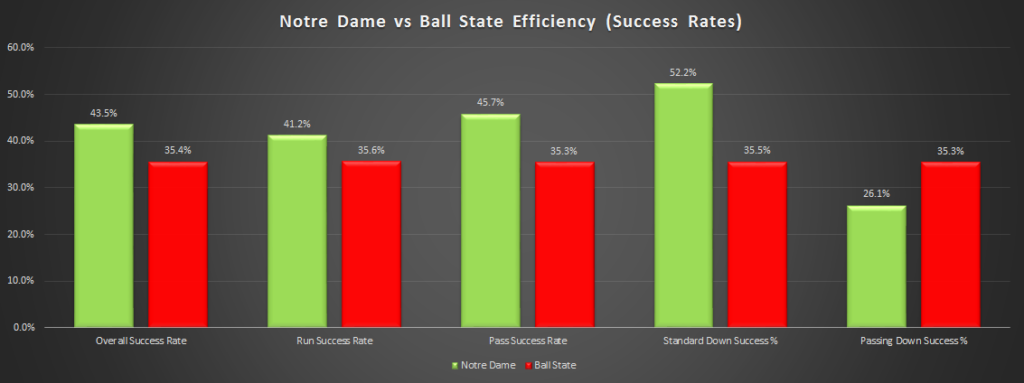
The primary concern, as it was entering the season, is Wimbush and the pass game. The play-calling and scheme for this game did him no favors – it seemed like the coaching staff wanted to tape him in bubble wrap and work on success as a pure passer. There were zero designed run calls for the QB in the first half, and zero scrambles (perhaps at the instructions of the staff). Wimbush’s running is arguably the most dangerous part of the offense. It was disheartening to see that without it the Irish couldn’t consistently score on Ball State, but also, why fight with one hand tied behind your back?
There’s enough of sample at this point to know that asking Wimbush to succeed solely as a pure passer isn’t viable. I still believe his running ability is so valuable that he’s still the best guy to run the offense. But if you aren’t going to let him use his legs as a threat, making the passing game easier as a result, why bother?
Still, Wimbush played poorly. Poor efficiency on passing downs against Michigan is to be expected – not so much against a MAC team. The encouraging signs of growth seen last weekend against the Wolverines – strong decision-making, not letting a bad play snowball into frustration and multiple misses – dissipated against a defense that could charitably be characterized as untalented. It seemed like the caution against running – whether designed runs or scrambling – threw Wimbush off. There were more than a handful of occasions to throw the ball away, and instead throws were forced or unnecessary yardage lost.
It wasn’t all awful – Wimbush completed 55% of his passes and averaged 17.5 yards per completion. Of the three interceptions, one was definitely not on the quarterback and a second was (like the Michigan pick) much in part due to pressure and getting hit while he threw. But against Ball State – playing fairly aggressively on defense – could Book have hit those open receivers? Or even Jurkovec? The intermediate throws were often wide open, so who knows if with a better passer under center if those are tighter windows but potentially the running lanes are a little wider.

How do you average 8+ yards on first down and still have an average 3rd down distance to gain of 9 yards plus? When you’re relying heavily on explosive plays, and not gaining many yards or losing them on other downs. The Irish offense was very boom or bust (as we will examine more closely in the explosiveness section), which history would tell us isn’t a sustainable way to perform at a high level.
Now for positive things – the Irish defense put on a very solid effort despite getting little help from the offense and special teams. The first Ball State drive produced a little anxiety, as the ND secondary played off Cardinal receivers and allowed Riley Neal to pick up some easy short completions and first downs. After that, it was pretty much a shut-down performance, with two picks and eight pass break-ups (four for Julian Love).
The two areas for improvement are closely linked – passing down efficiency and sack rate. Despite heavy pressure all game (9 QB hurries) the Irish tallied just one sack, although the guys in black and white were somewhat complicit. The old “if we hold every play, they can’t call it every play” was extremely effect for Mike Neu’s offense. Still, the Notre Dame defense should have come up with more sacks with better rush discipline, and that issue translated into Neal (did you hear he’s 6’6?) scrambling for multiple first downs.
Still, the Irish continue to limit opponent efficiency while forcing long drives and giving up very few big plays. A few more stops could have translated into better field position and maybe a few more points for the offense, but it’s hard to find much fault with the unit that’s avoided major mistakes and played fundamentally sound.
While the stars are largely performing like stars and getting the expected credit, a couple of unsung heroes of this game were Jonathan Bonner and Nick Coleman. Bonner hasn’t put up big numbers but had four QB hurries, and has made a fairly seamless transition to holding his own at the 1-tech as a fifth-year senior. Coleman had a couple of great plays in the nickel, including the deflection that led to Jalen Elliott’s first pick.
Explosiveness
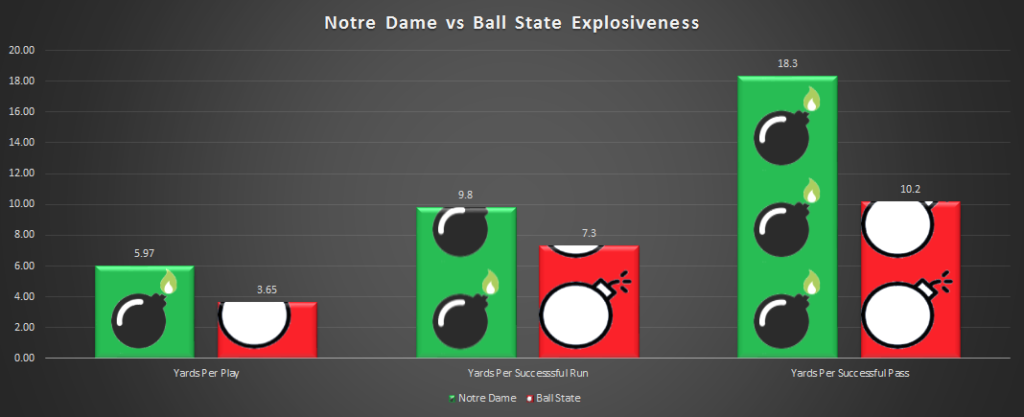
The saving grace for the Irish offense was that despite so-so efficiency, when they were successful they continue to be fairly explosive. There was just one gain of 40+ yards, and it came on the first series when Jafar Armstrong scampered for 42 and it looked like this game would be a stroll in the park. But there were also 13 gains of between 17 and 31 yards, with 11 of those coming through the air.
In a day without a lot of positives, Armstrong’s contribution in the passing game (3 catches for 61 yards) and a very productive day from Miles Boykin (6 for 119, despite a drop leading to a pick) stood out. The running back rotation continues to be a split between Armstrong (66 yards on 5.1 YPC) and Tony Jones Jr. (61 on 4.7, with a nice long TD). For an offense that’s dependent on big plays so far in this young season, Dexter Williams return from shadow suspension will be welcomed. If you’re going to need big plays to score, having one of your best big play threats taking some more carries helps double down on that effort.
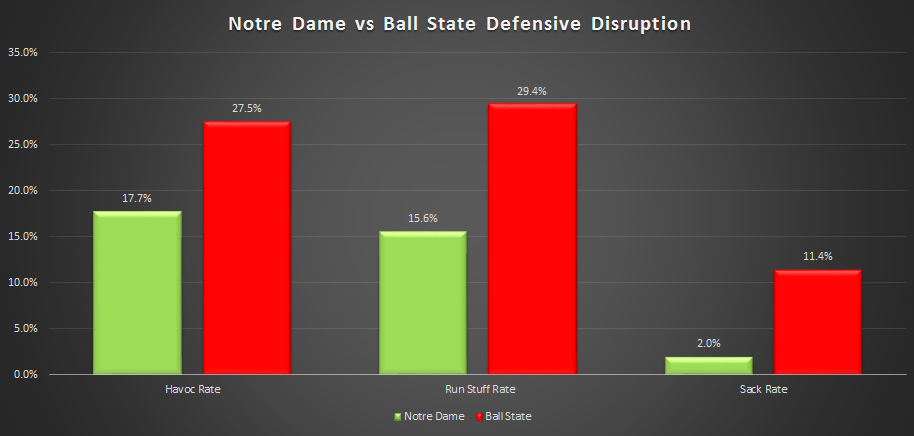
Somehow we’ve come this far without mentioning the offensive line. If you attempted to use the transitive property to apply how poorly the line looked against Ball State retroactively to Michigan, I would have expected approximately zero total yards in the opener. Some of this can be filed in the folder titled “consequences of a poor gameplan / Wimbush refusing to throw it away”, but the offensive line warning lights are officially on:
- Ball State posted a havoc rate of 27.5%, fueled by 10 tackles for a loss, three interceptions, and four pass break ups. Michigan led FBS last year with a team havoc rate of 23.7%.
- The Wolverines also led the nation last year in run stuff rate, at 28.9%. The Cardinals, who finished 128th in Rushing S&P+ defense in 2017, stuffed the Irish for negative yards or no gain on 29.4% of their carries.
It’s not all on the line, and Jeff Quinn, etc. – there were poor decisions involved too, from Wimbush to Jones of all runners deciding to reverse fields. But it’s certainly a disturbing start, especially given the lack of success on passing downs, which the Irish would very much like to avoid until the passing game looks better.
Advanced stat profiles aren’t up yet for the 2018 season, but the Irish defense has to again be close to the nation’s best in limiting explosiveness so far. Notre Dame is allowing just 3.95 yards per play this season, a mark that would have been best in FBS last year. There’s room for growth, and the competition will get tougher, starting next week (Kyle Shurmur is probably one of the better QB’s the Irish will see this season, although he suffers the disadvantage of only being 6’4 instead of 6’6).
Finishing Drives, Field Position, & Turnovers
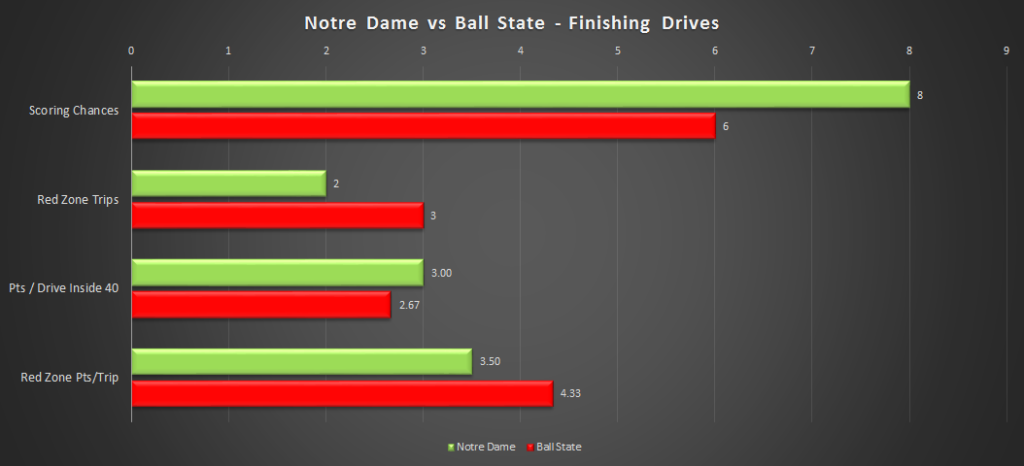
After a perfect effort in the red zone against Michigan, finishing scoring opportunities was a struggle for the Irish offense on Saturday. A red zone visit was snuffed out by a Wimbush sack followed by a missed Justin Yoon field goal. Another drive started with a first down on the BSU 28, then a ended with a two-yard rush and three straight Wimbush incompletions.
The saving grace was that Ball State had fewer scoring opportunities and were somehow worse converting them. The Cardinals, despite being massive underdogs, settled for four field goal attempts and punted from the Irish 40. Thanks Mike Neu!
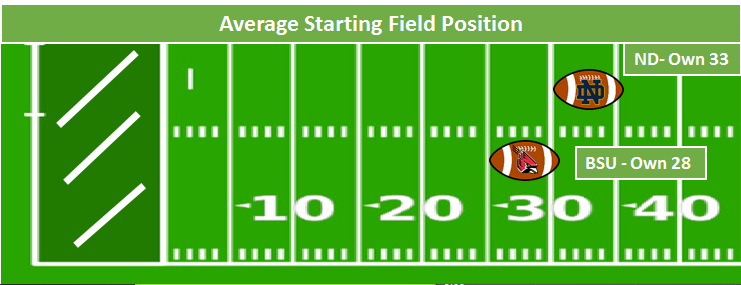
The Irish held a significant edge in the field position battle despite a so-so special teams effort. Jonathan Doerer putting another kickoff out of bounds was instant rage-fuel, but other than that his kick-offs were solid. I’d still take a touchback every time, but that’s just me. Tyler Newsome didn’t have his best performance either, averaging 36.4 yards per punt. Chris Finke fielding a bunch of punt returns live on the bounce (after signaling for everyone to watch out and move away from a short kick) seems non-ideal.
Fortunately the defense was steady, the offense picked up more yardage than Ball State, and better field position followed. Each of the three Irish interceptions were far enough downfield that they didn’t gift instant scoring opportunities. Starting field position now seems like a fairly trivial area of concern relatively to other parts of the team and offense, but I’m still worried it will pop up and bite Notre Dame in a close game.
On the subject of turnovers, Notre Dame lost that battle 3-2. While two of Wimbush’s picks weren’t completely his fault, there were also lots of deep passes thrown into double coverage and tight windows. An offense designed around Wimbush’s running ability with deep shots sprinkled in seems ideal for the ND offense. But so far the deep passing game has been inaccurate and often asking Irish receivers to make plays with a couple of defenders in the close vicinity (continual blessings for Chris Finke converting one such one-on-two opportunity in spectacular fashion in the opener).
Big Picture
This game was a gross slog, and I was extremely glad when it ended, except for that part where I kept hoping for a late TD or two to make the final score more respectable. Ultimately, the Irish are 2-0, and this poor performance can be easily rationalized away with more wins. Some combination of a terrible gameplan plus a letdown game and too-easy start led to a gross game that ultimately didn’t matter.
If we want to sip on some Kool Aid for a minute, and be receptive to the idea that these types of performances can still turned in by talented and good teams, even national championship caliber ones, allow me to present you two scores from Week 2, 2016. Clemson was coming off of a big win over Auburn, and UGA a win over a ranked UNC team:
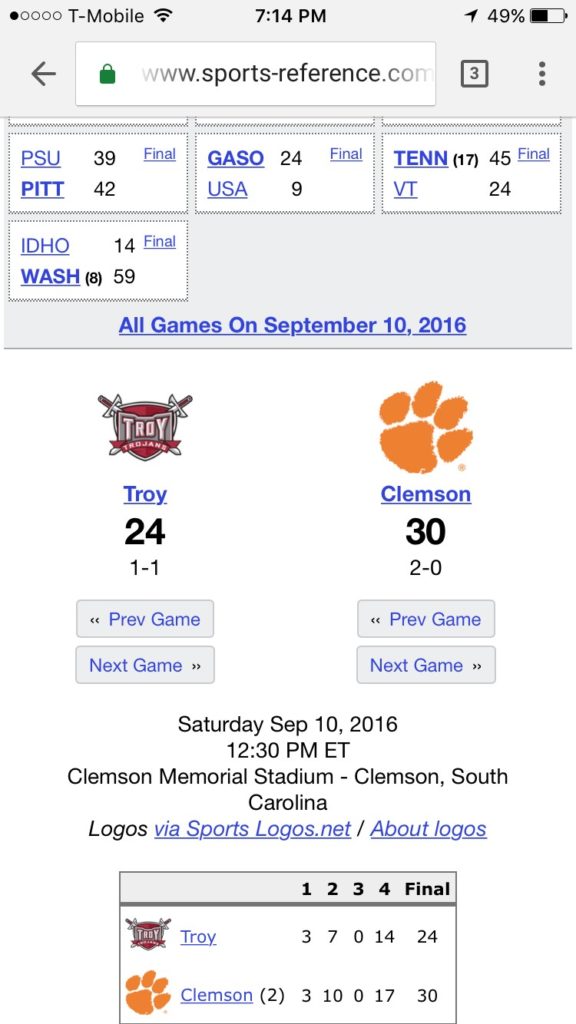
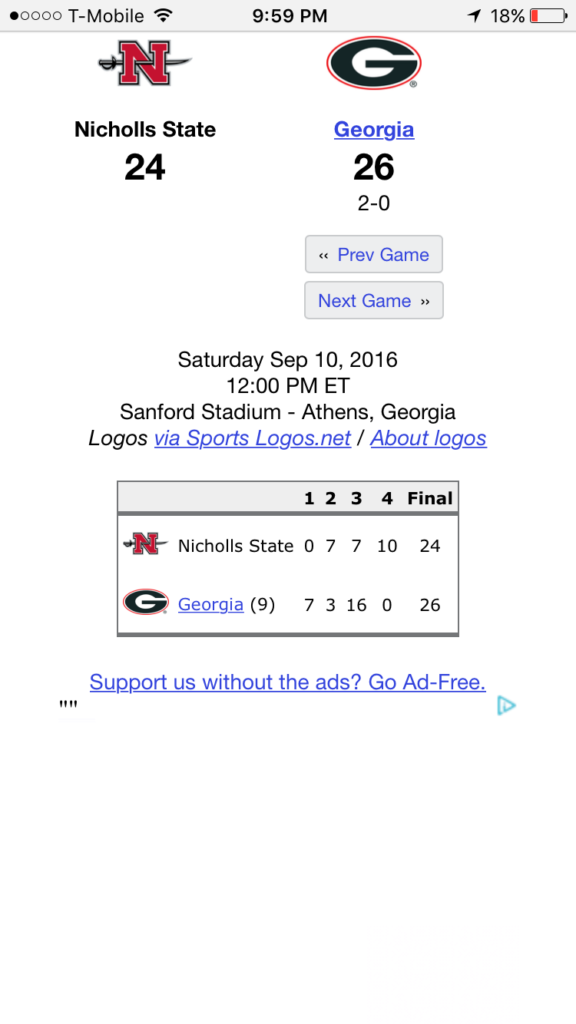
Finish September 5-0 and this will be a funny memory, except for the usual haters who will point to a win over Ball State by eight points as definitive evidence this team is no good. But it also could be the moment where we started to realize Wimbush 2.0 was really more Wimbush 1.01, or that the offensive line might be a liability for the season. The schedule will be the only true litmus test – one that annoyingly takes weeks before seeing what color our strip will turn.
Still, at the very least we know this is a missed opportunity, because most previews had key questions like “how many freshmen will play?” and “will Phil Jurkovec get to throw it when he’s in?”. This was the only obvious lay-up in a minefield schedule of teams expecting to make bowl games, and first-team starters had to play the entire game. It felt like a huge developmental win for the program last season to have so many big wins that allowed young players to gain experience, and now it’s hard to feel good about many of those opportunities coming up in any contest.
Notre Dame fell nine spots, to 17th, in S&P+ as a result. The rankings are extremely bouncy right now, as preseason projections are still included but slowly being phased out in favor of 2018 results. But 2018 results are still very messy, especially with opponent adjustments – it’s just hard to know through two games whose wins or losses or close games are good performances or not. Still, when you under-perform expectations but nearly 30 points against a team that was one of the worst in FBS last season, the computers aren’t going to smile favorable on you.
The defense is ranked 4th in Defensive S&P+, with the offense checking in at 77th. And that feels about right at the moment – Clark Lea’s crew is good enough to keep the Irish in and allow them to win every remaining game, but the offense so inconsistent and potentially one-dimensional that lots of close games also seem pre-destined if nothing changes. If anything maybe this struggle is a silver lining in its timing – the staff could have attempted to roll this conservative gameplan out against Vandy or Wake or Navy and suffered a loss as a consequence instead of a win that was ugly but never in doubt.
After the game, BK claimed that not running Wimbush was 1) not intentional and 2) part of “defining who we are as an offense. That’s what we’re trying to figure out. We have some new players that we’re putting in the mix. We’re in that process of kind of figuring out our identity on the offensive side of the ball.” That’s the concerning thing – there seems to be both an acknowledgement that they need to play to Wimbush’s strengths and avoid his weaknesses, yet a slow coming to grips with what exactly the offense is or should be. If a defense of Ball State’s caliber can be incredibly disruptive and through their looks force Wimbush to throw for the Irish to score, then we’ll see many repeats of that in the coming weeks.
A glance ahead at Vandy
The Commodores entered the season projected 79th by S&P+ in the preseason, coming off a 2017 that saw Derek Mason’s team finish 5-7 and 91st in F+. Two games in, and they’ve leapt to 23rd, beating the mighty powerhouses of Middle Tennessee State and Nevada. The Dores shut down MTSU 35-7 in the opener, spurred on by a 2-0 turnover deficit, and then beat the brakes off a bad Wolfpack team 41-10.
These performances have bumped Vanderbilt to 21st in Defensive S&P+, a rise which seems a little hasty for a team that finished 67th in the same category last fall. Still, the Commodore defense returned their best linebackers, and held MTSU to 3.2 yards per rush and Nevada to 1.4. It’s hard to argue with that early performance, even if the degree of difficulty is about to go up substantially.
The offense checking in at 43rd at this early juncture is a little more believable. Kyle Shurmur took a nice leap forward as a junior, throwing 26 TDs to 10 INTs and averaging 7.4 YPA (dragged down by expected struggles against Alabama and UGA). Junior WR Kalija Lipscomb is a big-play threat that had already tallied three touchdowns this season.
It’s worth noting that looking good against bad teams was kind of Vanderbilt’s MO last season. They turned in percentile performances of 88%+ against Tennessee, Middle Tennessee, Alabama A&M, and Western Kentucky. This was complemented by four performances worse than the 15th percentile against Bama, Florida, Georgia, and Ole Miss (those were all in consecutive games, by the way).
A quick aside – Bama might have broken them a little, because the numbers from that game are insane. The Tide won 59-0, with the Vanderbilt offense averaging 2.4 yards per play and 7.6 yards per possession. Vandy’s success rate was eight – 8!- percent. The offense’s percentile performance shows up as “NULL” on the advanced stat profiles. That’s bananas.
That tangent aside, it’s easy to see both 1) what S&P+ likes about Vanderbilt so far and 2) why skepticism that the Commodores will play up to the level of a quality Notre Dame team (presuming it plays at a top 10-20 quality level) is warranted. That said, there are things to dislike about the matchup- a veteran QB with a dangerous deep-threat, an offensive line returning all five starters, and a defense that has performed well against the run. Vandy’s front seven may not be great, but it’s certainly better than Ball State, which could become a problem if the offensive line doesn’t drastically improve this coming weekend.




Thanks for putting this together. These stats are brutal but not unexpected after the way we looked on Saturday.
What a stinker! Our OL acted like they had no idea how to defend against a 3-4 front. It seemed to me there multiple times an lineman was looking for someone to block or helping where it wasn’t needed while another defender (LB often) went untouched. I don’t know if that is just poor communication with the OL and QB or lack of familiarity with a 3-4 front, but neither seems like a good position for us to be in at this point. Also, Wimbush clearly believed (whether he was told this or not) that he should sit back and keep waiting for someone to open up downfield — it’s like his internal QB clock was turned off for the game. That resulted not only in some bad pressure and sacks but also in repeatedly throwing into double coverage.
It seemed like the coaches were hoping to put some good tape out there of Wimbush in the passing game to see if he might get more respect from defenses this season, but whatever they were trying to do with Wimbush wasn’t working.
Our defense, however, made some great adjustments and looks really good.
“or lack of familiarity with a 3-4 front”
I’ve read some iteration of this thought several times, but uh…isn’t that the purpose of watching film and practicing the week before the game?
Michigan runs a 3-4 though, as does Stanford and I think LSU too. It’s not like these guys have never in their lives seen one before. I don’t know what the hell was so confusing for the offense – I think it was just a slop-fest from the head coach down to the waterboy. Not a fun one to watch at all.
Even crazier, their offense lined up at one point with 3 WRs! Like, is that even legal!?!
Good to know that Michigan runs a 3-4 as well. It certainly was a slop-fest.
So did Jon Tenuta if I’m not mistaken. Can’t be that hard to defeat.
I think communication was definitely a major issue. The other piece is that I think Eichenberg going through growing pains was expected, but Hainsey has really looked bad early (against Winovich it seemed fine, now not so much). I’m guessing he’s not 100%, but wonder if 1) it’s the type of injury where he will be be able to heal during the season or just linger / get worse and 2) if he continues to struggle they consider a Lugg/Banks replacement or kicking Kraemer out to tackle to shuffle things and Lugg maybe at RG.
Could be worse, at least our lineman didn’t block each other…
And looking for that, I also found this!
GO GATAH
“After the game, BK claimed that not running Wimbush was 1) not intentional”
Yeah, I don’t buy this one bit. There were moments you could see BW think about running, then pull up as if he remembered he wasn’t supposed to.
“and 2) part of “defining who we are as an offense. That’s what we’re trying to figure out. We have some new players that we’re putting in the mix. We’re in that process of kind of figuring out our identity on the offensive side of the ball.””
And this seems to contradict the 1) part of what he said. If you’re doing X because you’re trying to figure out who you are, then isn’t that “intentional”? “Well, not running BW wasn’t intentional, but we were trying to see if we could do these other things as part of our journey of self-discovery…just figuring out who we are as an offense, and really accepting ourselves for that, you know? Next week against Vandy, we’re going to run the “take a summer to backpack across Europe” offense to really see if we can find ourselves. Hopefully that works, and we don’t have to employ the “get high and end up with a tribal tattoo tramp stamp in a back alley tattoo parlor in Pattaya” offense against Wake Forest.”
He did that with Golson a few times too. BK seems to have trouble learning from his mistakes.
The difference being that Golson was a much better passer, and WImbush is a better runner.
lol, truly cannot tell if joke or serious 😛
Sometime the memes are true 🙂
If you’re a defense playing ND, there’s no reason to not have 8 guys in the box every play. I hope when Dex is back Armstrong gets some time in the slot with Dex in the backfield. They need some sort of downfield threat to stretch the field.
I like that idea–Armstrong looked good receiving, better than as a runner unless there was a big hole most anyone could have run through….
Since the only thing good about this week is the opportunity for schadenfreude, let’s go there:
Kentucky 27 – Florida 16
Eastern Michigan 20 – Purdue 19
Samford 26 – FSU 36 (FSU was losing after 3 quarters)
USC 3! – Stanford more than 3
MSU 13 – ASU 16
What is leverage rate, Michael?
It’s the percentage of your offensive plays that are standard downs. So a low leverage rate (both teams here were below average) equates to a high number of passing downs – 2nd and 8+, 3rd and 5+. I’m theory on standard downs running and passing are both viable paths so the offense has the “leverage”.
Thanks also for you back and forth on last weeks post, I meant to follow up on it. On many of those pieces we agree to disagree but appreciate your engagement, perspective, and keeping it civil when I was irritable
Thanks Michael, much appreciated.
Much like Larz, Mike’s version of lashing out when irritable is to put two lumps in your tea when you quite clearly asked for just one. I’m sorry you had to experience that, kiwi. Just brutal.
Hehe, regarding an “UGA win over a ranked UNC team” i’m wondering if UNC should be considered an “erroneously ranked team” 😛
Watching ND try to lose to an inferior team (again) was frustrating, but seeing North Caroline get hammered by F/+ #126 East Carolina was amusing.
hey now, that team had future top 2 pick Mitch Trubisky and Elijah Hood!
But agree, pretty funny watching Fedora / that program collapse. Some karma working there after they ducked serious sanctions with made up classes.
That Troy team that tested Clemson was not really that bad, though. They were actually ranked (no. 25) at one point late in the season, and finished 11-3 after winning their bowl game (albeit against Ohio, but still).
That’s a good point…..another one, just for kicks – in 2015, Week 3 Ohio State beat Northern Illinois 20-13. Probably a better MAC team than Ball State, but finished 8-6 overall, and that was a Buckeye team that had an incredible amount of NFL talent.
Troy was coming off a 4-8 season that year though, so at the time it would’ve seemed a lot like this. While I do feel it’s unlikely, Ball State could be the 2016 Troy for all we know. They did get a lot of guys back from injury, and apparently brought in some JC guys who played a lot.
Reading this makes me feel ☹️
The hash marks facing the dome makes me feel 🤗
Attention to detail–the team regressed, but Michael made the great “week 1 to week 2” improvement we expected!
I’ve heard this complaint about officials not calling holding, but I’m rewatching the game right now and I dont see it. I’m about halfway through the 3Q and I’ve only seen 3 holding calls that could have been called but were passed on. Of those, one of them would have been very marginal so I’d forgive them for letting it go. It was on the play near the GL where Neal scrambled for a 1st down to the 2 in the 1Q. There were back to back plays where they definitely missed 2 holdings but the second was on a 3rd and was an INC pass so would likely have been declined anyway.
What I DO see that is a bigger concern is that there are two missed blocking below the waist fouls that were missed. As this is a rule change and a point of emphasis again, missing these is not good. One was on an interception return and you cannot EVER block low on those. Alohi was cut blocked right before Elliot was tackled. The second, Tranquill was blocked at the side by a lineman outside the 10 and 2 region when the ball was in the side zone. These are both major fouls and you can’t miss those as an official.
Here’s what I’ve seen so far:
1Q 7:40(or so, I didnt get the exact time) missd holding…marginal call
2Q 11:47 missed holding, restriction
2Q 11:41 missed holding hook and turn
2Q 8:30 Missed IBW on turnover
2Q 4:28 Missed IBW outside 10-2 ball outside tackle box
This applies to pretty much any during-game comments, but I wouldn’t read too much into people complaining about holding. You’re a ref. You’re trained on what to look for. Most of us are not, and in the heat of the moment are going to react even when we’re not sure what we’re talking about.
@Except for me, of course@
Can you do this for the Bears-Packers game from Sunday night? Packers LT false started at least 3 times and wasn’t flagged.
Didnt watch the game(I was working middle school ball) but I talked to an NFL line judge last year while I was working chains for a Cowboys game. We had a similar play where Jason Witten clearly flinched and I saw the L start to reach for a flag before not calling it. I asked him at half why he passed on it. He told me that their philosophy on that is if the defense doesn’t react and no one mentions it, they will let it go. That ties into the “gain an advantage” philosophy. You dont cause the defense to do something it doesnt want to do and it’s not helping you do something that wouldnt normally benefit you. May as well let it go.
Interesting. I didn’t know the officials had the ability to be subjective on that type of infraction. LT (Baluga [SP?]?) was moving early, not just flinching, though.
The philosophy is “Talk em out of the 5 yard fouls(meaning if you can make it legal, try to do so unless it becomes habitual or gains an advantage), Get the 10 yarders at the point of attack, and flag every 15 yard foul regardless of where it occurs.
From what you’re describing, it may have happened simultaneous with the snap.
On the cut block issue–any idea how that’s affecting Navy?
Well, they lost to Hawaii, so maybe it’s having something to do with it? I dont know how you’d draw a straight correlation. IIRC, most of their cut blocks occur by the linemen at the LOS, not so much downfield. That’s going to be where the effect will be, if they try to employ downfield low blocks which are now illegal. The other change, of course, is that backs now have to block within 10-2 whereas last year, they could block low anywhere.
There were two that jumped out for me. The first:
https://twitter.com/BGI_CoachD/status/1039334983100522496
https://twitter.com/BGI_CoachD/status/1039282075294203904
I don’t know the game time of those and if either lines up with your list, but to me they’re both pretty blatant. The first shows the center bear hugging Tillery as he goes by, with Tillery finally ripping his arm up in exasperation to get the guy off. Before that you can see his jersey move and his lead shoulder get yanked down.
The second has two on the same play, by the RT and RG, with both defenders clearly being pulled back away from the direction they’re trying to go. The one on Kareem was particularly bad. That’s a 3rd down scramble near the goal line, but it can’t be the “very marginal” one you note above, can it? Because that doesn’t look marginal at all to me.
Jamie at ISD tweeted during the game that he saw Tranquill held badly on 2nd down and Tillery on the ensuing 3rd down, and also called out the hold of Kareem on that scramble. This isn’t just fanboy ravings here. I’ll concede that it’s tough in the trenches, but when guys are obviously held out in space and at the point of attack it has to be called.
T-mobile??? Really Michael??? Is that what they are handing out for the 18S company phone???
the one carrier who is cool with 20+ writers with different addresses and last names being included as a family plan!
I’m surprised they still offer a party-line cell service. It is nice being able to call one number and ring y’all at the same time.
very annoying though to have my phone ringing all the time and everyone just wants to talk to larz, who is too busy training the bears to ever pick up
He should be training the bears to pick up. Seriously, what kind of offshore call-center using animal labor is he running over there?
100% serious question:
Can we poach Boston College’s OL Coach and OC? What that team has done offensively the past 2 years is astonishing.
We interviewed him and Kelly picked Quinn instead. I know it’s too early to seriously evaluate Quinn, but I too am feeling some buyer’s remorse.
Was just talking about this on twitter, but it’s pretty humorous because their OC, Scot Loeffler, was bad at Auburn then bad at VT and awful initially at BC (2016- early 17). Now apparently he’s figured it out? Or partnering with Addazio they’ve found it? We think of these coaches as usually pretty static, good or bad, but they can innovate and adapt or not, and he apparently has.
Justin Frye was their OL coach but left to go to UCLA. Agree he was a strong candidate but way early to tell and if you like what BC is doing this year, he ain’t there any more.
Didn’t realize Frye left for UCLA. Will be interesting to keep an eye on them, too.
Y’all are awesome for staying on top of this stuff and sharing it with those of us who don’t have time or are too lazy to do so 🙂